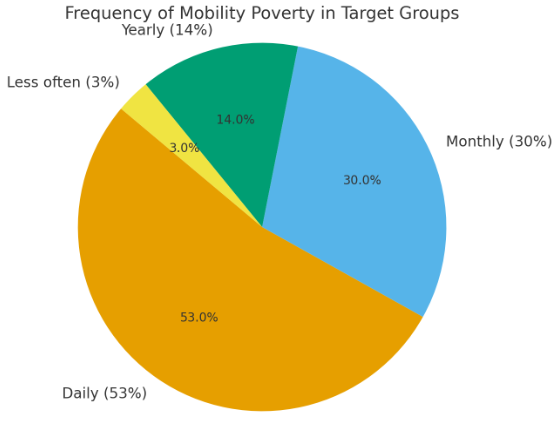In the summer of 2025, IGEMO conducted an online survey among frontline professionals working with vulnerable groups. The survey was part of a pilot designed to generate actionable insights into mobility poverty, foster cross-sector understanding between mobility professionals and social workers, and translate this knowledge into concrete recommendations for local and regional authorities.
The pilot is not an isolated experiment but embedded within the broader framework of regional mobility governance. Its findings will inform the Regional Mobility Plan, support council-level decision-making, and lay the groundwork for future collaborative projects across sectors.
Five key findings
1. Widespread but unevenly distributed
Frontline workers report significant differences within their target groups: some people face no issues, while a majority (53%) struggle with mobility on a daily basis. The most vulnerable groups are low-income households, people with disabilities, older adults, and single parents. Less affected are youngsters/ children, and migrants/ refugees.

2. Low income as the main risk factor
A low income emerges as the single most important driver of mobility poverty, followed by physical limitations, age, and single parenthood.
3. Severe consequences for daily life
Mobility poverty limits access to healthcare, employment, and social participation (loneliness). It also hampers access to basic services, especially for homeless people and individuals with physical or intellectual disabilities.
4. Existing solutions fall short
Known measures such as public transport discounts, Mobitwin/community transport, and bicycle initiatives are frequently mentioned. However, respondents stress the need for more affordable, accessible, and better tailored mobility options.
5. Methodological limitations
The survey results provide valuable signals but should be interpreted with caution. With 70 respondents, the sample size is limited. Moreover, the recruitment strategy relied on existing networks, which may have led to selection bias and underrepresentation of certain organisations or groups. Moreover, the survey was conducted among intermediates, professionals who work in a first line position with the target groups that suffer from mobility poverty. This approach was chosen because the actual target groups are not easy to survey. This indirect approach may bias our understanding of the problem.
Why it matters
Mobility poverty is not a one-off challenge but a systemic issue requiring long-term, adaptive responses. By building durable professional networks and shared reference points, the pilot aims to stimulate lasting collaboration across sectors. This collaborative approach will help local and regional authorities design mobility policies that are inclusive, resilient, and socially just.
